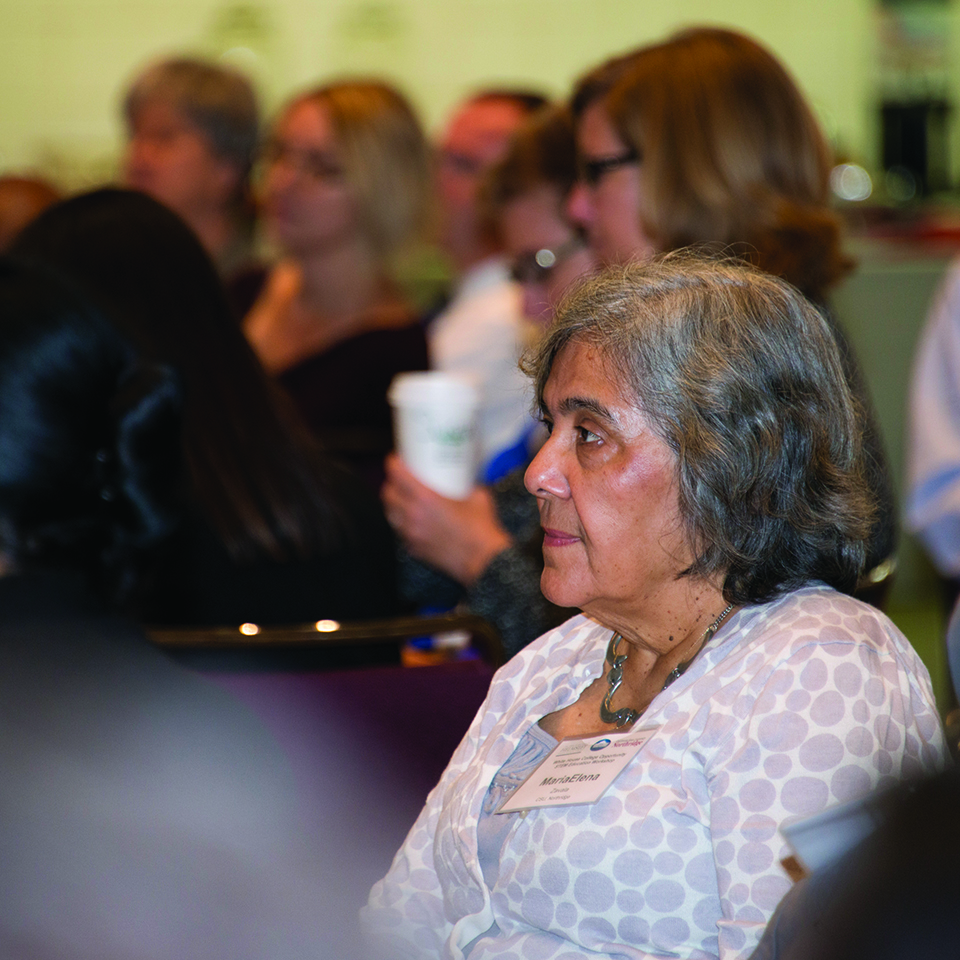National STEM Leaders Brainstorm for Student Success
White House representatives joined California State University, Northridge faculty and administrators and more than 80 science, technology, engineering and mathematics (STEM) education leaders from across the country at CSUN on Oct. 7 to cultivate strategies for keeping students in STEM fields, with the goal of making the United States more competitive in a technologically savvy global market.
The White House workshop, co-sponsored by CSUN and The Leona M. and Harry B. Helmsley Charitable Trust, highlighted ways to recruit and retain women, underserved minorities and first-generation college students in STEM fields. These groups statistically have the lowest numbers in science and engineering fields, according to Patricia Falcone, the White House’s Associate Director for National Security and International Affairs of the Office of Science and Technology Policy.
The workshop was part of the Obama Administration’s efforts to expand college opportunity for more first-generation, low-income and underserved students, building momentum toward the second White House College Opportunity Summit later this year.
Falcone said women occupy only 28% percent of STEM careers in the U.S., and 60 percent of students who enter STEM majors leave those STEM fields before graduation.
“It is a fact that students from underserved communities often lack the tools and resources early on to get inspired and prepared to study STEM in high school and beyond,” Falcone said. “But it is also a fact that young people, by nature, are curious and creative about how to solve problems in the world around them. We must offer support to students to gain the foundational skills they need to succeed in STEM careers.”
CSUN President Dianne F. Harrison noted that the university serves a highly diverse community, with two-thirds of its students being first-generation college students and more than 18,000 students eligible for Pell Grants. Harrison highlighted CSUN’s efforts to enrich the STEM student pipeline and improve student outcomes by addressing student readiness, giving students hands-on experiences and confidence and providing the foundation for students to carry their success forward beyond the classroom and into careers and graduate school.
“As one of the most diverse universities in this country, we take great pride in our historical commitment to provide access to traditionally underserved communities,” Harrison said. “Student success and degree attainment are our top priorities in all fields, including STEM.”
One example of a long-running CSUN program successfully elevating underrepresented student achievement is the Maximizing Access to Research Careers (MARC) program funded by the National Institutes of Health. The program, which is directed by CSUN biology professor Maria Elena Zavala, aims to increase the number of traditionally underrepresented students prepared to lead in research careers in basic biomedical sciences. Since 1990, 36 former MARC students have completed and an additional 17 CSUN students are currently in doctoral programs.
Panel speakers and conference participants discussed ways to prepare and inspire students in STEM fields. Some said starting exposure to hands-on science and engineering earlier in education was vital to getting students STEM-ready for college.
CSUN biology professor Steven Oppenheimer spoke about the university’s work with local grade schools on integrating more STEM experiences in the classroom and how research kept students focused on science. Oppenheimer pointed to the annually published “The New Journal of Student Research Abstracts,” which spotlights the young scientists’ work.
“We start with elementary school level,” Oppenheimer said. “We started many decades ago. The kids were excited. … They come to Northridge and present their posters. This has been a tremendous success. The students are turned on to science. Research, in my opinion, is key and it should start as early as possible.”
Others added that building career paths for students was vital to keep them motivated and on track for the future.
Panelist Peggy Nelson M.S. ’91 (Electrical Engineering), vice president of engineering and global product development at Northrop Grumman Aerospace Systems, said female role models are vital to keeping students inspired in their careers.
“I have learned that the role model of a lady engineer cannot be underestimated,” she said. “Women need to be kept in the workforce. We need to provide them the role models. … We need professors to be supportive. We need those kinds of relationships where we have diversity.”
Internships also give students an edge in the career field, said panelist Anna Park, chief executive officer of Great Minds in STEM.
“What students are being asked to do is not found in a textbook,” Park said. “Having that access really will differentiate them.”
S.K. Ramesh, dean of CSUN’s College of Engineering and Computer Science, moderated a breakout session on Connections to Career and Industry. He spoke about the role of mentoring and undergraduate research activities in attracting and graduating students from diverse backgrounds in STEM fields. CSUN’s AIMS2 program, supported by a five-year, $5.5 million grant from the U.S. Department of Education, was recently recognized by the Excelencia Foundation as a national exemplar of breaking down barriers and successfully supporting and graduating underserved students in Engineering and Computer Science.
“To err is human. To engineer is divine. To educate is sublime,” Ramesh said. “We need to take an all-hands-on-deck approach to echo the call from the National Academies to strengthen and diversify our nation’s capabilities in STEM Education.”




 experience
experience